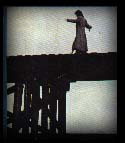| As Patricia Waugh points out, "Metafiction is a term given to fictional
writing which self-consciously and systematically draws attention to its
status as an artifact in order to pose questions about the relationship
between fiction and reality" (2). Metafiction blurs the boundary between
life and art, fiction and criticism, and fiction and reality.
Housekeeping doesn't show the elements of metafiction in its
form but in its content. The centric issue of Housekeeping, as
the main characteristic of metafiction, is blurring boundary.
In Housekeeping, the boundaries such as life and death, inside and
outside, nature and domestic place, and past and present are all blurred.
Here, I am going to use water image, the lake in this novel, as an example
to show how the boundary between life and death is blurred.
I. The passage about the lake in Housekeeping:
 It is true that one is always aware of the lake in Fingerbone, or the deeps
of the lake, the lightless, airless water below. When the ground is plowed
in the spring, cut and laid open, what exhales from the furrows but that
same, sharp, watery smell. The wind is watery, and all the pumps and creeks
and ditches smell of water unalloyed by any other element. At the foundation
is the old lake, which is smothered and nameless and altogether black.
Then there is Fingerbone, the lake of charts and photographs, which is
permeated by sunlight and sustains green life and innumerable fish, and
in which one can look down in the shadow of a dock and see stony, earthy
bottom, more or less as one sees dry ground. And above that, the lake that
rises in the spring and turns the grass dark and coarse as reeds. And above
that the water suspended in sunlight, sharp as the breath of an animal,
which brims inside this circle of mountains. (9)
It is true that one is always aware of the lake in Fingerbone, or the deeps
of the lake, the lightless, airless water below. When the ground is plowed
in the spring, cut and laid open, what exhales from the furrows but that
same, sharp, watery smell. The wind is watery, and all the pumps and creeks
and ditches smell of water unalloyed by any other element. At the foundation
is the old lake, which is smothered and nameless and altogether black.
Then there is Fingerbone, the lake of charts and photographs, which is
permeated by sunlight and sustains green life and innumerable fish, and
in which one can look down in the shadow of a dock and see stony, earthy
bottom, more or less as one sees dry ground. And above that, the lake that
rises in the spring and turns the grass dark and coarse as reeds. And above
that the water suspended in sunlight, sharp as the breath of an animal,
which brims inside this circle of mountains. (9)
 Explanation:
The lake, which has four levels, is changeful. Explanation:
The lake, which has four levels, is changeful.
(Actually, in this novel, nothing is fixed; even the house cannot be
kept in the end).
I. The first level of the lake: the deepest level, the old lake where
the dead are. (The grandfather and Helen, Ruth and Lucille's mother are
dead in this lake.)
2. The second level of the lake: Fingerbone itself, the lake of human
life and memory, the town can be a lake, the town is a lake and part of
the lake. When there is a flood, the town is immersed in the lake.
3. The third level of the lake: it also touches life because the plants
and grass absorb water from the soil.
4.The last level which is on the surface of the lake: the dampness in
the air, water suspended in sunlight, the lake can rise and turn into air.
II. Boundary between life and death
-
As for the lake itself: There are levels of death and life of the lake.
Since the air and the soil are watery (and the circulation of water and
air), the boundary between life and death is blurred. Thus the lake itself
can be seen as all of human existence (include life and death) are unstable
and changeful as the lake presents.
-
As for the town and the lake: Through flood, there is no boundary between
the town and the lake; again, no boundary between life (the town) and death
(the lake). [Actually, the flood also makes no distance between Sylvie's
house and the town (inside and outside)]
-
There is no boundary between life and death, furthermore, no boundary between
absence (the dead) and presence.
III. The characters who long for rootless
are more akin to the lake.
-
The grandfather who is anxious about "foreshortened" perspective pioneers
the descent into the lake.
-
Sylvie who likes the freedom of nature often spends her time at the lake
and returns home "with fish in her pockets" (136).
-
Ruth who also inclines for transient life likes go to the lake either for
escaping human society or for remembering her mother.
|